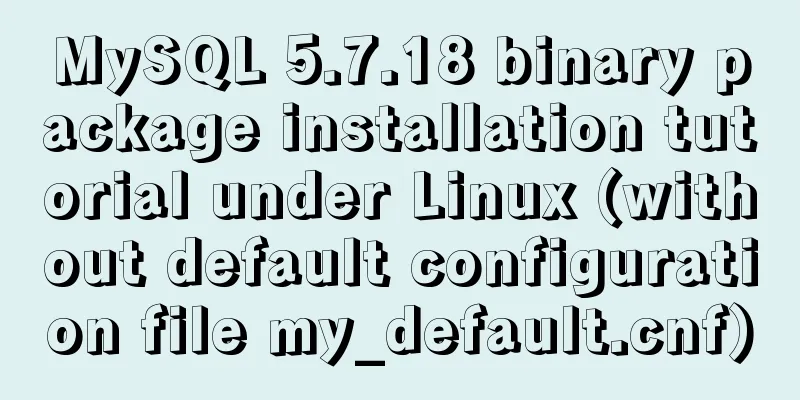MySQL 5.7.18 binary package installation tutorial under Linux (without default configuration file my_default.cnf)

|
I am currently learning MySQL. I am a complete novice and don’t know much about Linux. I downloaded the latest version of MySQL (MySQL5.7.18) binary package and tested and installed it under CentOS7.2 to facilitate future work. The approximate steps are as follows. After installing and deleting the files several times, there should be no problem if you follow the steps below. It is not as complicated as you might think. Most of the steps are based on references from the Internet. Just follow them. If you make mistakes, try more and check more information. Operating system version
Create mysql group and user
Download the latest version of MySQL 5.7.18 binary package and upload it to the usr/local directory of the server
Unpack the MySQL binary package
The following is the file information after decompression and renaming the folder
Change the group and user
The contents of the decompressed MySQL file
Check the contents of the
I found a configuration file on the Internet, as follows, and uploaded it to the supp-files folder. Of course, this configuration file can be modified as needed. # For advice on how to change settings please see # http://dev.mysql.com/doc/refman/5.7/en/server-configuration-defaults.html # *** DO NOT EDIT THIS FILE. It's a template which will be copied to the # *** default location during installation, and will be replaced if you # *** upgrade to a newer version of MySQL. [mysqld] sql_mode=NO_ENGINE_SUBSTITUTION,STRICT_TRANS_TABLES # General configuration options basedir = /usr/local/mysql datadir = /usr/local/mysql/data port = 3306 socket = /var/run/mysqld/mysqld.sock character-set-server=utf8 back_log = 300 max_connections = 3000 max_connect_errors = 50 table_open_cache = 4096 max_allowed_packet = 32M #binlog_cache_size = 4M max_heap_table_size = 128M read_rnd_buffer_size = 16M sort_buffer_size = 16M join_buffer_size = 16M thread_cache_size = 16 query_cache_size = 128M query_cache_limit = 4M ft_min_word_len = 8 thread_stack = 512K transaction_isolation = REPEATABLE-READ tmp_table_size = 128M #log-bin=mysql-bin long_query_time = 6 server_id=1 innodb_buffer_pool_size = 1G innodb_thread_concurrency = 16 innodb_log_buffer_size = 16M innodb_log_file_size = 512M innodb_log_files_in_group = 3 innodb_max_dirty_pages_pct = 90 innodb_lock_wait_timeout = 120 innodb_file_per_table = on [mysqldump] quick max_allowed_packet = 32M [mysql] no-auto-rehash default-character-set=utf8 safe-updates [myisamchk] key_buffer = 16M sort_buffer_size = 16M read_buffer = 8M write_buffer = 8M [mysqlhotcopy] interactive-timeout [mysqld_safe] open-files-limit = 8192 [client] /bin/bash: Q: command not found Upload the above default configuration file to the support-files folder as follows
Register and initialize the MySQL service This is a bit tricky. Most of the tutorials on the Internet are installed using the mysql_install_db method. This step is also the most problematic. I struggled for a long time, but the mysql_install_db command is not recommended. It also prompts to use mysqld to install. When installing MySQL 5.7.18, there are also various errors. After various attempts, use the following naming method to install. As long as there is no Error, ignore the warning message Warning bin/mysqld --initialize-insecure --user=mysql --basedir=/usr/local/mysql/ --datadir=/usr/local/mysql/data/
Copy the above my_default.cnf and mysql.server configuration files to the etc directory. The files have been copied to the etc directory before. It prompts whether to overwrite. Enter Y to overwrite.
Start MySQL Service
Connect to MySQL. There is no password by default. Press Enter to connect to MySQL.
Change MySQL root password
Modify remote access
Restart MySQL service
At this point, you can use MySQL normally locally
Testing Remote Connection
You may also be interested in:
|
<<: How to deploy nextcloud network disk using docker
>>: Summary of various ways to create objects in js and their advantages and disadvantages
Recommend
Analysis and solution of data loss during Vue component value transfer
Preface In the previous article Two data types in...
HTML implements the function of automatically refreshing or opening a new window for the URL link of the a element href
Sometimes we want to implement such a function: c...
About browser compatibility issues encountered and solutions (recommended)
Preface: Last Sunday, a senior asked me to help m...
Using radial gradient in CSS to achieve card effect
A few days ago, a colleague received a points mal...
How to use node scaffolding to build a server to implement token verification
content Use scaffolding to quickly build a node p...
MySQL data archiving tool mysql_archiver detailed explanation
Table of contents I. Overview 2. pt-archiver main...
How many ports can a Linux server open at most?
Table of contents Port-related concepts: Relation...
Detailed usage of kubernetes object Volume
Overview Volume is the abstraction and virtualiza...
Don’t bother with JavaScript if you can do it with CSS
Preface Any application that can be written in Ja...
Web front-end development course What are the web front-end development tools
With the development of Internet technology, user...
HTML page jump and parameter transfer issues
HTML page jump: window.open(url, "", &q...
Implementation of mysql data type conversion
1. Problem There is a table as shown below, we ne...
MySQL Index Optimization Explained
In daily work, we sometimes run slow queries to r...
Detailed tutorial on how to install OpenStack Ussuri in CentOS8 with minimal deployment
The tutorial for installing OpenStack Ussuri with...
Detailed explanation of the use of ElementUI in Vue
Login + sessionStorage Effect display After a suc...




























